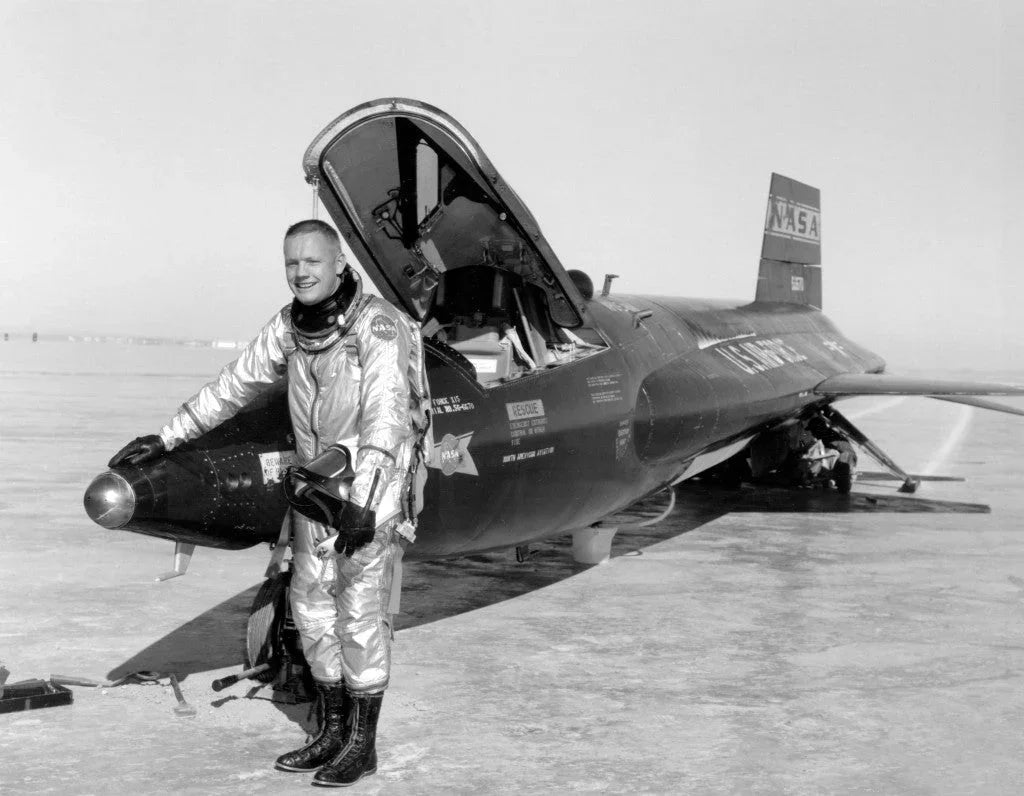The Amazing Story of the X-15: A Revolutionary Spaceplane

North American Aviation, Inc., X-15A-1, 56-6670, at Los Angeles Division, October 1958. (Air Force Flight Test Center History Office)
Since the first flight of the Wright Flyer on December 17, 1903, aeronautical engineers focused their efforts on designing aircraft that would fly at ever-increasing speed and at higher and higher altitudes.
On October 14, 1957, Capt. Chuck Yeager made aviation history by becoming the first pilot to fly faster than the speed of sound.

Captain Chuck Yeager sitting in the cockpit of the Bell X-1 aircraft.
A series of specially designed aircraft - called the X-planes, were designed to extend the limits for speed and altitude.
In the 1950s supersonic airplanes had become the central focus of aircraft design. Within a few years, Lockheed had built the first production military aircraft capable of flying at Mach 2 (twice the speed of sound).
This was the F-104 Starfighter.

3 Views of the Lockheed F-104 Starfighter
The F-104 Starfighter was designed by Kelly Johnson and the Lockheed Skunk Works, and the F-104 was a beautiful example of the aerodynamics required to build such an excellent supersonic aircraft.
The next X-series aircraft, the X-15, was born on October 5, 1954, when the National Advisory Committee for Aeronautics decided on the need for a manned hypersonic research airplane.
North American Aviation won the aviation industry competition and then designed and built the X-15.
North American Aviation had designed the famous P-51 or World War II fighter, and they also designed the first American swept-wing fighter aircraft, the beautiful F-86 Sabre Jet of Korean War fame.
While the Bell X-1 was a rocket-powered aircraft, the X-15 was a quantum leap in technology. It was a spacecraft!
The X-15 rocket plane was designed and built to explore the effects of hypersonic flight (Mach 5+). Design work began in 1955 and a mockup was completed after just 12 months.
Three X-15s were built at the North American Aviation Los Angeles Division which was located at the southeast corner of the LAX (Los Angeles International Airport).
The X-15 had a long, flattened fuselage, short stubby wings, wedge-shaped tail surfaces, and a black surface to help radiate away the high temperatures generated by aerodynamic heating.
X-15 Specifications
- Length: 50.75 feet;
- Wingspan: 22.36 feet;
- Height: 13.5 feet
- Empty Weight: 14,600 pounds;
- Maximum Weight: 34,000 pounds;
- Powerplants: Reaction Motors XLR99-RM-1 rocket engine.
Boeing NB-52A
On November 29, 1957, the third production Boeing B-52A-1-BO Stratofortress was flown from Boeing's Seattle assembly plant to the North American Aviation facility at Air Force Plant 42, Palmdale, CA, to be modified to carry the new X-15 hypersonic research rocketplane.
Starting on February 4, 1958, a pylon was mounted under the bomber's right wing.
Also, a 1,500-gallon liquid oxygen tank was installed in the B-52's bomb bay.

The X-15 was attached to this underwing pylon by three remotely-actuated standard Air Force bomb shackles. (NASA)
A large notch was cut into the trailing edge of the inboard flap to accommodate the X-15's vertical fin.

To allow clearance for the X-15’s vertical fin, a notch had to be cut in the trailing edge of the inboard right flap.
A station for a launch operator was installed on the upper deck of the B-52 at the former electronic countermeasures position.
A series of control panels allowed the panel operator to monitor the X-15’s systems, provide electrical power, and to keep the rocketplane’s liquid oxygen tank full as the LOX boiled off during the climb to launch altitude.
The operator could see the X-15 through a plexiglas dome, and there were two television monitors.

NB-52 liquid oxygen panel.
After modifications were completed at Palmdale, 52-003 was flown to Edwards Air Force Base, 14 November 1958.
The first X-15 flight took place on June 8, 1959, when Scott Crossfield, a North American Aviation test pilot was strapped into the cockpit.

Scott Crossfield prepares for a flight in the North American Aviation X-15
With the X-15 mounted under the wing of the NB-52A on June 8, 1959, the bomber climbed to an altitude of 37,550 feet and released the X-15, which then glided to the desert floor below.
Even though this first flight was a non-powered gliding flight, the X-15 still reached a speed of Mach 0.79 during the descent.
This first flight was the start of one of the most spectacular test programs with one of the most spectacular aircraft in history.
The program ended on October 24, 1968, after the last flight (flight number 199) which took a total of 11 minutes and 28 seconds reaching 255,000 feet and accelerating to Mach 5.38.
More to come next week....
I hope you enjoyed this trip through some of the history of aviation. If you enjoyed this trip, and are new to this newsletter, sign up to receive your own weekly newsletter here: Subscribe here:
Until next time, keep your eyes safe and focused on what's ahead of you, Hersch!







Leave a comment
This site is protected by hCaptcha and the hCaptcha Privacy Policy and Terms of Service apply.